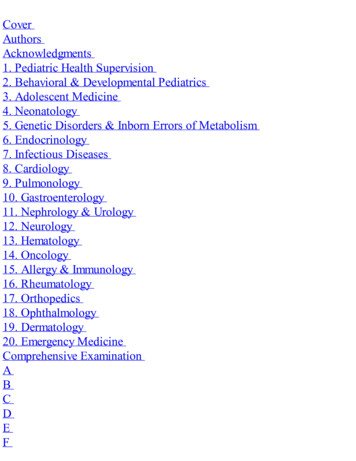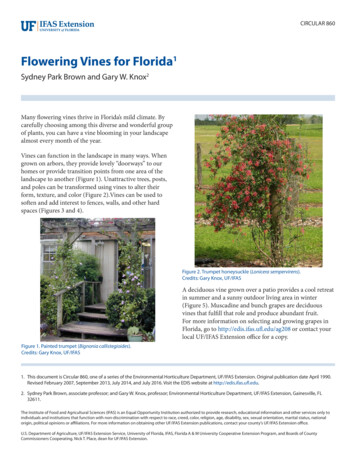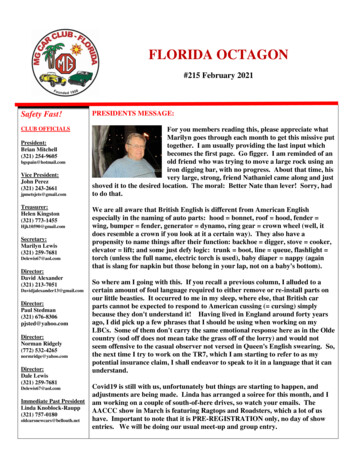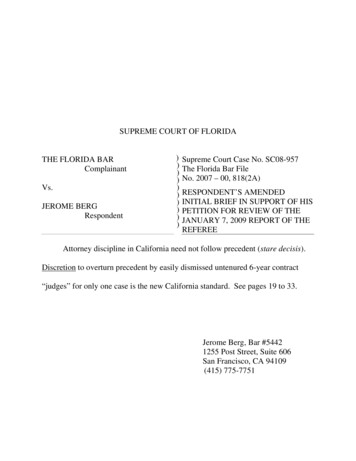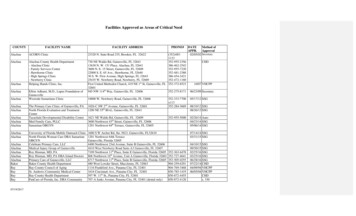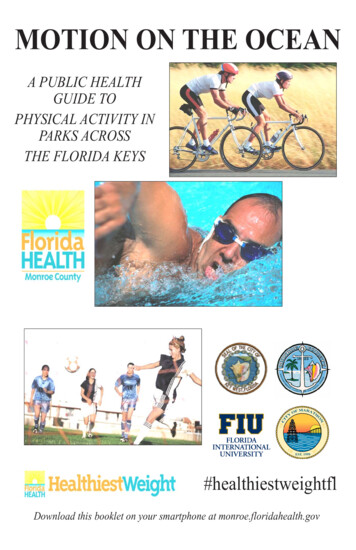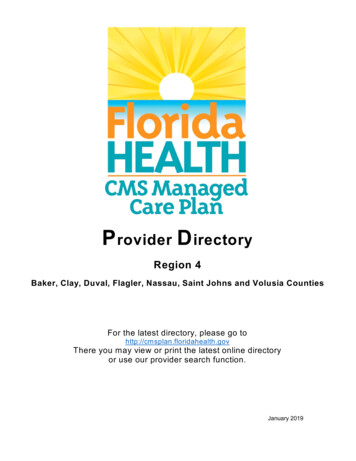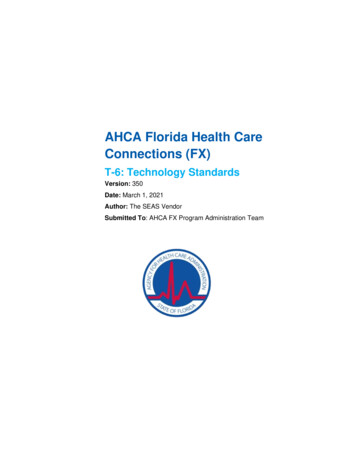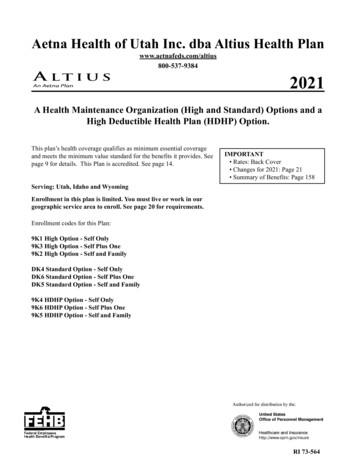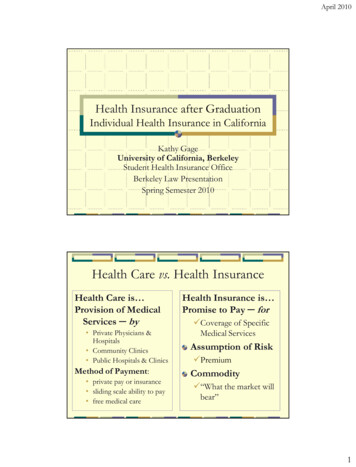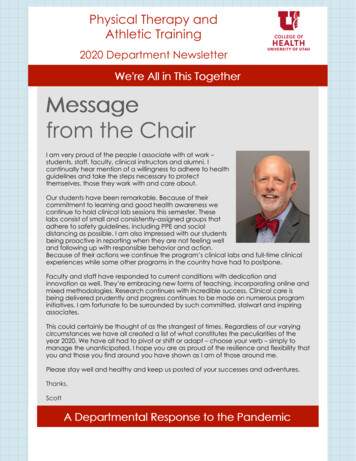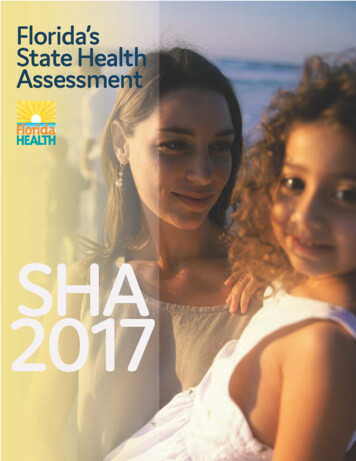
Transcription
AcknowledgmentsSTATE HEALTHIMPROVEMENT PLAN (SHIP)STEERING COMMITTEEAndrew BehrmanFlorida Association ofCommunity Health CentersTony CarvajalFlorida Chamber FoundationLisa ContiFlorida Department ofAgricultureTrenia L. CoxJuvenile Welfare Board ofPinellas CountyMichelle CrumOffice of the Attorney GeneralMeredith DaSilvaVISIT FloridaMike DewFlorida Department ofTransportationMike HillFlorida Association of HealthPlanning AgenciesDean IzzoFlorida Department ofEconomic OpportunityJane JohnsonFlorida Department of Childrenand FamiliesRoderick KingFlorida Institute of HealthInnovationsAlexis LambertFlorida Department of HealthCarla Gaskin MautzFlorida Department ofEnvironmental ProtectionMolly McKinstryFlorida Agency for Health CareAdministrationSarah McKuneUniversity of FloridaCeleste PhilipFlorida Department of HealthLillian RiveraFlorida Department of Healthin Miami-Dade CountyPaul RowleyFlorida American IndianAdvisory CommitteePenny TaylorFlorida Department ofEducationSTATE HEALTH ASSESSMENTADVISORY GROUP (SHA-AG)Carina BlackmoreDivision of Disease Control andHealth Protection, FloridaDepartment of HealthBen BrowningPolicy and Regulatory Affairs,Florida Association ofCommunity Health CentersTony CarvajalFlorida Chamber FoundationJeff CeceSubstance Abuse and MentalHealth Program, FloridaDepartment of Children andFamiliesSteve ChapmanDivision of Public HealthStatistics and PerformanceManagement, FloridaDepartment of HealthMichelle CrumOffice of the Attorney GeneralChuck FairclothFlorida Department ofVeteran’s AffairsiJeff FellerWellFlorida CouncilMarisela GarciaFlorida Department ofEconomic OpportunityLucy GeeDivision of Medical QualityAssurance, Florida Departmentof HealthKim GokhaleUniversity of FloridaChristina HarrisOffice of the Attorney GeneralNikole HelveyFlorida Center for Informationand Policy Analysis, FloridaAgency for Health CareAdministrationLakeisha T. HoodFlorida Department ofAgriculture and ConsumerServicesChristine HomFlorida Institute of HealthInnovationShannon HughesDivision of Community HealthPromotion, FloridaDepartment of HealthBrittany HuntFlorida Chamber FoundationMark JamesMuscogee Indian ParamedicWayne KigerWaste Management, FloridaDepartment of EnvironmentalProtectionRoderick KingFlorida Institute of HealthInnovations
Jerry LangFlorida American Indian HealthAdvisory CouncilPatty LewandowskiFood Safety, FloridaDepartment of Agriculture andConsumer ServicesXimena LopezFlorida Department of Healthin Miami-Dade CountyMike MasonOffice of Minority Health,Florida Department of HealthJohn McCaffreyOffice of InformationTechnology, FloridaDepartment of HealthEd McEachronDivision of Administration,Florida Department of HealthWayne NorthDivision of EmergencyPreparedness and CommunitySupport, Florida Departmentof HealthCassandra PasleyDivision of Children’s MedicalServices, Florida Departmentof HealthLola PounceyDivision of Medical QualityAssurance, Florida Departmentof HealthPaul RowleyFlorida American Indian HealthAdvisory CouncilSharon SawickiWater Resource Management,Florida Department ofEnvironmental ProtectionJessica SimsFlorida Department of Childrenand FamiliesNicole StookeyFlorida Department of Childrenand FamiliesDeb WatsonWinter Park HealthFoundationKaren WellerFlorida Department of Healthin Miami-Dade CountyDavid WhitingDivision of EnvironmentalAssessment and Restoration,Florida Department ofEnvironmental ProtectionHEALTH STATUSWORKGROUPDuane AsheFlorida Department of Health,Bureau of CommunicableDiseasesCarina BlackmoreFlorida Department of Health,Division of Disease Control andHealth ProtectionTracina BushFlorida Department of Health,Bureau of CommunicableDiseases, HIV & HepatitisProgramPhilip Cavicchia*Florida Department of Health,Bureau of Public HealthResearchShay ChapmanFlorida Department of Health,Bureau of Family HealthServicesCheryl Clark*Florida Department of Health,Bureau of Children’s MedicalServicesLeah ColstonFlorida Department of Health,Bureau of Emergency MedicalOversightiiMary CrewFlorida Department of Health,Bureau of Emergency MedicalOversightRahel DawitFlorida Department of Health,Bureau of Chronic DiseasePreventionRussell Eggert*Florida Department of Health,Bureau of EpidemiologyJamie ForrestFlorida Department of Health,Bureau of Chronic DiseasePreventionKendra GoffFlorida Department of Health,Bureau of EnvironmentalHealthJanet HamiltonFlorida Department of Health,Bureau of EpidemiologyMeredith HennonFlorida Department of Health,Bureau of Public HealthResearchRhonda HerndonFlorida Department of Health,Bureau of WIC ProgramServicesTara HyltonFlorida Department of Health,Bureau of Public HealthResearchLori JohnsonFlorida Department of Health,Bureau of CommunicableDiseasesMelissa Murray JordanFlorida Department of Health,Bureau of Public Health ResearchJeanne LaneFlorida Department of Health,Bureau of PerformanceAssessment and Improvement
Christie LuceFlorida Department of Health,Bureau of Preparedness andResponseMegan MacdonaldFlorida Department of Health,Bureau of Family Health ServicesLorene MaddoxFlorida Department of Health,Bureau of CommunicableDiseases, HIV & HepatitisProgramLauren PorterFlorida Department of Health,Bureau of Public HealthResearchLaura ReevesFlorida Department of Health,Bureau of CommunicableDiseases, HIV & HepatitisProgramKeshia ReidFlorida Department of Health,Bureau of Chronic DiseasePreventionShamarial Roberson*Florida Department of Health,Bureau of Chronic DiseasePreventionPat Ryder*Florida Department of Health,Bureau of CommunicableDiseasesStacy ShiverFlorida Department of Health,Division of Disease Control andHealth ProtectionNancy SpykerFlorida Department of Health,Bureau of WIC Program ServicesDan Thompson*Florida Department of Health,Bureau of Community HealthAssessment, Florida CHARTSSTATE PUBLIC HEALTHSYSTEM ASSESSMENTPARTICIPANTSClaudia BlackburnFlorida Department of Healthin Leon CountyBrandon E BrantleyFlorida Department of HealthJeffrey CeceFlorida Department of Childrenand FamiliesKaren ChapmanFlorida Department of Healthin Okaloosa CountySteven ChapmanFlorida Department of HealthAdrian CookseyFlorida Department of Healthin Gadsden CountyNathan DunnFlorida Department of HealthRussell EggertFlorida Department of HealthJames FutchFlorida Department of HealthMara K. GambineriFlorida Department of HealthMeredith HennonFlorida Department of HealthRhonda HerndonFlorida Department of HealthTom HerringFlorida Department of HealthDaphne HoldenFlorida Department of HealthAbigail HollickyFlorida Department of HealthKen JonesFlorida Department of HealthWayne KigerFlorida Department ofEnvironmental Protection*subgroup memberiiiBrandi KnightFlorida Department of Healthin Leon CountyXimena LopezFlorida Department of Healthin Miami-Dade CountyMike MasonFlorida Department of HealthArlesia MathisFlorida A&M University—College of Pharmacy andPharmaceutical Sciences,Institute of Public HealthWayne NorthFlorida Department of HealthJerry ParrishFlorida Chamber FoundationLola PounceyFlorida Department of HealthKeshia ReidFlorida Department of HealthShamarial RobersonFlorida Department of HealthPat RyderFlorida Department of HealthWilliam M. SappenfieldUniversity of South Florida—College of Public HealthSTATE FORCES OF CHANGEASSESSMENT PARTICIPANTSBen BrowningFlorida Association ofCommunity Health CentersTony CarvajalFlorida Chamber FoundationJeff CeceFlorida Department of Childrenand FamiliesSteven ChapmanFlorida Department of Health,Division of Public HealthStatistics and PerformanceManagement
Vanessa CrowtherFlorida Department of Health,Office of Minority HealthMichelle CrumOffice of the Attorney GeneralChuck FairclothFlorida Department ofVeteran’s AffairsJeff FellerWellFlorida CouncilKim GokhaleUniversity of FloridaChristina HarrisOffice of the Attorney GeneralNikole HelveyFlorida Agency for Health CareAdministrationShannon HughesFlorida Department of Health,Division of Community HealthPromotionBrittany HuntFlorida Chamber FoundationPatty LewandowskiFlorida Department ofAgriculture and ConsumerServicesAnna LikosFlorida Department of Health,Division of Disease Control andHealth ProtectionXimena LopezFlorida Department of Healthin Miami-Dade CountyEd McEachronFlorida Department of Health,Division of AdministrationLola PounceyFlorida Department of Health,Division of Medical QualityAssuranceSharon SawickiFlorida Department ofEnvironmental ProtectionJessica SimsFlorida Department of Childrenand FamiliesNicole StookeyFlorida Department of Childrenand FamiliesKaren WellerFlorida Department of Healthin Miami-Dade CountyDavid WhitingFlorida Department ofEnvironmental ProtectionSTATE HEALTH ASSESSMENT/STATE HEALTH IMPROVEMENTPLANNING TEAMVanessa CrowtherDavid DavisJeff FellerJulia FitzJasmine HayesSierra HelfrichDaphne HoldenShurell KnightJoanne SteeleDan Thompsoniv
Table of ContentsIntroduction . 1Florida Demographic and Socio-Economic Characteristics . 2State Health Assessment Process . 8The Four MAPP Assessments . 9State Health Status Assessment . 10State Public Health System Assessment. 12State Forces of Change Assessment . 13State Themes and Strengths Assessment . 13Using the Key Findings to Select Priority Areas. 14Key Findings ― Infographics . 15Behavioral Health . 16Cancer . 17Chronic Disease . 18Injury Prevention . 18Healthy Weight . 19Immunizations & Influenza. 20Maternal Health & Birth Outcomes . 21Sexually Transmitted Diseases . 22Tobacco, Alcohol & Substance Abuse . 23Appendix A: State Health Status Assessment Findings. 24Social & Economic Factors: Social Determinants of Health .A1–A10Health Behaviors . B1–B13Clinical Care Issues, State Assets and Resources. C1–C14Physical Environment, State Assets and Resources . D1–D7Health Outcomes . E1–E28Appendix B: State Public Health System Assessment Findings . 96F1–F30Appendix C: State Health Themes and Strengths Assessment Findings . 127G1–G5Appendix D: State Forces of Change Assessment Findings . 133H1–H3Appendix E: List of Tables. 137I1–I4v
IntroductionThe Florida Department of Health (Department) is leading a diverse partnership, the StateHealth Improvement Plan Steering Committee, to build Florida’s State Health ImprovementPlan (SHIP) for 2017-2021. The SHIP is a statewide plan for public health system partners andstakeholders to improve the health of Floridians.To develop the SHIP, the partnership conducted a comprehensive state health assessment toidentify the most important health issues affecting Floridians. A comprehensive assessmentensures that the priorities selected for the SHIP are shaped by data about the health status ofour residents, the effectiveness of Florida’s public health system in providing essential services,residents’ perceived quality of life and how factors outside of health might impact health nowor in the future.1
Florida Demographic andSocio-Economic CharacteristicsOverviewFlorida is the fourth most populous state in the nation. In 2017, approximately 20.6 millionpeople lived in Florida. The state’s population is characterized by its distinctive age structure;19.4% of the population in Florida is age 65 or older, a proportion higher than any other state inthe nation.1 The 0 to 19 age group comprises 22.6% of Florida’s population and 58.0% are in the20 to 64 age group.2 This section presents a snapshot of Florida’s dynamic population groupsand aims to illustrate general characteristics of Florida’s diverse population with commonlyused indicators of the status of populations.The most up-to-date picture of Florida’s population comes from the ongoing AmericanCommunity Survey (ACS) conducted by the U.S. Census Bureau.2 By conducting monthly surveysof a sample of the U.S. population, the ACS collects economic, social, and housing informationcontinuously rather than every 10 years as done by the decennial census. Five-year estimatesare available for every location in the United States, no matter how small. Census data reportedin this document come from these 2013-2017 aggregate estimates.2Florida’s PopulationAgeAccording to the 2017 U.S. Census American Community Survey (ACS)2, Florida had a totalpopulation of 20.3 million, 10.4 million females and 9.9 million males. The median age ofFlorida’s population was 41.8 years which was higher than the U.S. median age of 37.8 years. InFlorida 19.4% of the population was above age 64. This was higher than the U.S. percentageabove age 64 which was 14.9%.The graphs below show the age distribution in Florida compared to the U.S. for males andfemales. The graphs show that Florida tends to have higher proportions in the older age groupsand lower proportions in the lower age groups, compared to the U.S.2
8.0%7.0%6.0%5.0%4.0%3.0%2.0%1.0%0.0%Percent of Female Population by AgeU.S. and Florida ACS 5-Year Estimates 2017FL female8.0%7.0%6.0%5.0%4.0%3.0%2.0%1.0%0.0%US femalePercent of Male Population by AgeU.S. and Florida ACS 5-Year Estimates 2017FL maleUS male3
Race/EthnicityAccording to the ACS 5-year estimates for 2017,2 91.8% of Florida’s population was of the blackrace (16.1%) or white race (75.7%). The third highest percentage was for the Asian race at 2.7%,depicted in the pie chart below.Percent of Florida population by RaceACS 5-Year Estimates 201716.1%2.6%2.7%2.5%0.3%0.1%75.7%Black or African AmericanOther raceAsianTwo or more racesAmerican Indian and Alaskan NativeNative Hawaiian and Other Pacific IslanderWhite4
Florida has a more diverse Hispanic population and a higher percentage of Hispanics than thenation overall.2 Among Florida residents, 24.7% were Hispanic compared to 17.6% for the US. InFlorida, the most common country of origin for Hispanics was Cuba which accounted for 7.2%of the Florida population. (see pie graph below) In contrast, for the US the most commoncountry of origin for Hispanics was Mexico with 11.1% of the US population. In the US Cubanscomprised 0.7% of the population.Percent of Florida Population by Hispanic StatusACS 5-Year Estimates 20173.4% 5.3%7.2%8.9%75.2%MexicanPuerto RicanCubanOther Hispanic or Latino5Non-Hispanic or Latino
EducationAccording to the ACS 2013 – 2017 estimates,2 87.6% of Florida’s population age 25 or oldergraduated from high school or had education beyond high school. In the U.S., the percentagewas virtually the same at 87.3%. In Florida, the percentage of the population aged 25 or olderthat had a bachelor’s degree or higher was 28.5% compared to 30.9% for the U.S. The graphbelow shows the percentages of the 25 and older population by education level.Percent of Population Age 25 by Education Level:Florida and U.S. 2013 - 2017Graduate or professional degreeBachelor's degreeAssociate's degreeSome college, no degreeHigh school graduate (includes equivalency)9th to 12th grade, no diplomaLess than 9th grade0.0%10.0%USFlorida620.0%30.0%40.0%
Income and PovertyAccording to the ACS 2013 – 2017 estimates,2 the median household income in Florida was 50,883. This is 11.7% lower than the U.S. median income for the same period: 57,652. At thehigh end of the income range, the percentage of households with incomes of 200,000 andabove was 9.2% in Florida and 12.1% in the U.S. On the low end of the range, the percentage ofhouseholds with incomes below 10,000 was 7.2% in Florida and 6.7% in the U.S.The lower income distribution in Florida is also evident in the poverty statistics. The percentageof persons below poverty level was 15.5% in Florida and 14.6% in the U.S. This pattern isreflected across all age groups and in general younger persons are more likely to be livingbelow the poverty level in the U.S. and in Florida. The graph below shows the percentage ofpersons below poverty by age group.Percentage of Population Below Poverty LevelFlorida and U.S. 2013 - 201765 years and over35 to 64 years18 to 34 years5 to 17 yearsUnder 5 years0.0%Source: ACS 2013 - 20175.0%10.0%15.0%US20.0%25.0%30.0%FLSources1. World Atlas: with-the-oldest-population.html2. U. S. Census, American Community survey: index.xhtml7
State HealthAssessment ProcessIn January 2016, the Florida Department of Health, along with public and privatepartner organizations, engaged in a state health improvement planning processusing a state-level adaptation of the National Association of City and County HealthOfficials’ (NACCHO) Mobilizing for Action through Planning and Partnership (MAPP)strategic planning model.MAPP is a community-driven strategic planning process for improving community healthby identifying strategic issues from four assessments, and setting priorities andimplementing evidence-based initiatives to advance health (Figure 1). Facilitated bypublic health leaders, this framework helps communities apply strategic thinking toprioritize public health issues and identify resources to address them. MAPP is not anagency-focused assessment process; rather, it is an interactive process that can improvethe efficiency, effectiveness and ultimately the performance of local public healthsystems. 11National Association of County & City Health Officials (NACCHO). (2016). Mobilizing for action through planning andpartnerships (MAPP). Retrieved from h
Tara Hylton . Florida Department of Health, Bureau of Public Health Research . Lori Johnson . . Stacy Shiver . Florida Department of Health, Division of Disease Control and Health Protection . . Office of the Attorney General . Nikole
